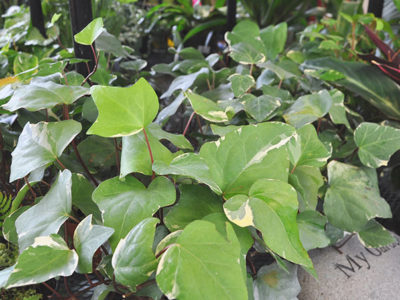The common houseplant doesn’t appear to be doing much of anything—it just sits there looking pretty.
Pick any houseplant and stare at it all day long. You might see its leaves wave in the breeze as the air conditioning cranks up. You could witness a dead leaf drop to the floor with a gentle crackle. If you’re lucky, you’ll notice a bloom open, adding a touch of color to your decor. It’s not even trying to look busy.

Despite the seeming lack of activity, green plants (indoors and out) are constantly working to grow and stay alive. And it’s this critical action that maintains the air we need to grow and stay alive.
It’s surprisingly easy to forget that those still, silent plants are engaged in an ongoing energy exchange with us—we exhale carbon dioxide, plants “inhale” carbon dioxide, plants “exhale” oxygen, we inhale oxygen. As if that wasn’t enough, science has shown that green plants (even standard houseplants) are continuously purifying our air too. (Apparently being pot bound doesn’t prevent plants from earning their keep.) Since we’re spending more and more of our lives locked up indoors, we can now elevate the peace lily from decoration to partner in good health.
If man is to move into closed environments, on Earth or in space, he must take along nature’s life support system. ~B.C. Wolverton
Research Shows Houseplants Remove Chemicals From the Air
In the 1970s NASA scientists were researching ways to create long-term living environments for humans in space. They knew that synthetic building materials, furniture, and people give off chemicals that need to be ventilated or absorbed in some way to maintain a suitable atmosphere. Scientists identified 107 of these chemicals inside the Skylab space station.
Around that same time, the U.S. was in the midst of an energy crisis and builders started constructing tightly sealed, energy-efficient buildings. These buildings lowered utility bills but created a new kind of illness—Sick Building Syndrome. Workers reported eye irritation, headaches, fatigue, difficulty breathing, and sinus congestion. As NASA already knew, you can’t lock people away in synthetic buildings with no outside ventilation and expect them to stay healthy.
NASA funded scientist B.C. Wolverton to research the use of plants to clean the air in sealed environments, with the idea that this could be useful for humans in space and on Earth. Wolverton selected twelve common houseplant species from a local nursery. He then tested those plants for their ability to absorb three common chemicals found in the Skylab space station: benzene, trichloroethylene (TCE), and formaldehyde.
Wolverton’s research showed that standard houseplants do clean the selected chemicals from the air in sealed environments. Each plant species offered different levels of chemical uptake, but they all showed the ability to reduce indoor air pollution.
Here is a selection of the plants he tested…
5 Common Houseplants that Clean Air
- Peace lily
- English ivy
- Chinese evergreen
- Bamboo palm
- Green spider plant
*The chrysanthemum and Gerbera daisy were high-performers in this study, but I’ve never considered them to be houseplants. If you want to bring your mums inside though, by all means do.
**Wolverton continued this research and eventually published a book, How to Grow Fresh Air, that lists 50 houseplants species that purify air.
Houseplants do far more than just add color to your home or office. Placing just a few of them in your living space will help to clean the air you breathe on a regular basis. And some degree of indoor air pollution is a given when you live in enclosed spaces with furniture, carpet, and other people.
(Wolverton showed in subsequent studies that you need one plant per 100 square feet of living space for maximum cleaning efficiency.)
Oh, and the next time you notice a plant in your midst, send it some appreciation for all that it’s doing to keep you healthy and alive on this planet. It’s far busier than it looks.
Sources:
Interior Landscape Plants for Interior Air Pollution Abatementhttp://ntrs.nasa.gov/archive/nasa/casi.ntrs.nasa.gov/19930073077.pdf
http://ntrs.nasa.gov/archive/nasa/casi.ntrs.nasa.gov/19930073077.pdf
Plants Clean Air and Water for Indoor Environments
http://spinoff.nasa.gov/Spinoff2007/ps_3.html
http://spinoff.nasa.gov/Spinoff2007/ps_3.html

